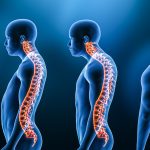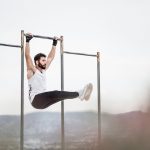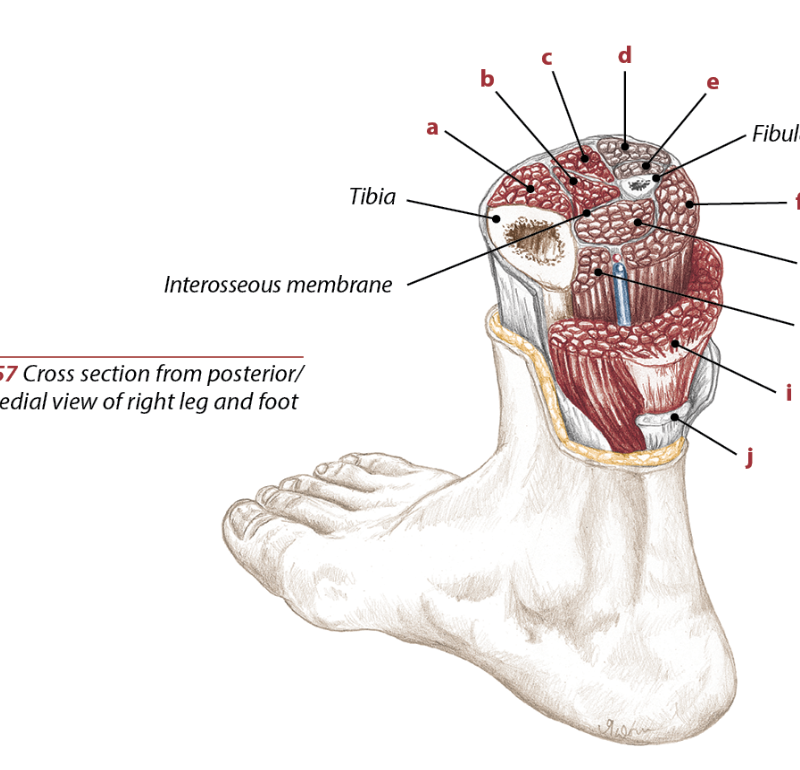
Identify the location of anterior tibialis and cue ankle and foot exercises more effectively with clients. I hope you are working your clients ankles and feet. The feet are the first part of the body to hit the ground and what happens at the feet doesn’t stay at the feet…it travels up!
Anterior Tibialis Anatomy
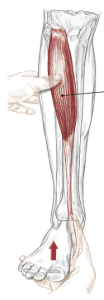
Originating on the lateral condyle of the tibia, the proximal lateral surface of the anterior tibia and interosseous membrane, “ant tib” matches up to its name! This powerful shin muscle inserts onto the dorsal side of the base of the 1st metatarsal and medial cuneiform.
If you dorsiflex your ankle you can see the prominent tendon of the anterior tibialis on the distal end of your lower leg, right when your ankle joint is formed. You can follow the tendon superior up toward your knee to feel the muscle attaching to the tibia and interosseous membrane.
Anterior Tibialis Function
Invert your foot to strengthen the contraction of tibialis anterior to wrap your mind around it’s two main motions – ankle dorsiflexion and foot inversion. It shortens concentrically every time you bring your foot toward your shin and lengthens eccentrically right before you place your foot on the ground.
Perhaps the eccentric function of anterior tibialis is why shin splints are so prominent in runners. When the foot is moving at a higher velocity, anterior tibialis has to react more forcefully to counteract the demands being placed on the ankle and foot.
One of my favorite facts about anterior tibialis is that it shares an insertion with peroneus/fibularis longus. Except anterior tibialis is on the dorsal side of the lower leg and peroneus longus is on the plantar side.
Together, these two muscles make a sort of holster for the foot. With opposing actions. Peroneus longus plantar flexes the ankle and everts the foot. Anterior tibilias does exactly the opposite.
Locate your first metatarsal and cuneiform to connect with these two muscles and explore their functions while feeling the insertion points.
Anterior Tibialis Exercise
Have your client seated with knees bent to 45 degrees. Ask them to dorsiflex and invert the foot. You can apply manual resistance to the dorsal foot or use a resistance band wrapped around the dorsal foot.
Anterior and Posterior Tibialis – Synergists and Antagonists
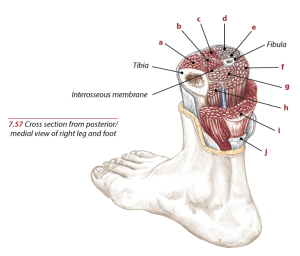
Anterior (a. in cross-section image) and posterior (g. in cross-section image) tibialis are automatically thought of as antagonists because one is on the front lower leg performing dorsiflexion and the other on the back of the lower leg performing plantarflexion.
But, hang on one minute.
Both muscles insert around the medial side of the foot making them both vehicles for foot inversion and synergists. They are also antagonists because anterior tibialis dorsiflexes the ankle and posterior tibialis plantarflexes the ankle.
Muscular function is quite complex when you examine it closely. The same two muscles can be synergists and antagonists to one another. Even the same muscle can be an antagonist and synergist to itself!
Understanding the muscles role in plantar flexion and dorsiflexion as well as how they work with the peroneal muscles is key to programming exercise for the stable base that (should be) your feet.
Anterior Tibialis Study Tip
To remember any muscle better, find the attachment points on yourself. Invert and plantarflex your ankle while placing your hand where the attachment sites are to feel the contraction of the muscles via the tendons. Using a balloon or rubber band is a way to bring the muscle to the outside of the skin so you can better visualize what it doesn’t.
When you’re walking, pay attention to the role that these muscles have in every step you take.
Learning anatomy and muscle attachments enable you as a personal trainer to create effective exercises and cue proper form with your clients. Keeping bodies strong and your business healthy. It’s important to strengthen these muscles with the same emphasis you place on the pectoral group or the abdominals.
Anatomy and biomechanics is a subject that requires lifelong learning. The human body has hundreds of muscles that provide infinite options for locomotion. Be sure to incorporate foot and ankle exercises into your exercise programs. They are important!
[info type=”facebook”]Join the conversation on the NFPT Facebook Community Group.[/info]
References
Abrahams, P.H. et al. 2003. McMinn’s Color Atlas of Human Anatomy. London: Elseiver.
Biel, Andrew. 2014. Trail Guide to the Body revised 5th edition. Colorado: Books of Discovery.
Muscolino, Joseph E. 2004. Musculoskeletal Anatomy Coloring Book. Philadelphia, PA: Mosby, Inc.
Expand your anatomy knowledge further with NFPT’s Fundamentals of Anatomy Program.
Balloons, play-doh, pipe cleaners, and ribbons are used to demonstrate each muscle with its attachment point on a skeleton model in a series of videos. You’re also shown how to find the attachments on yourself and/or clients. Application exercises and guided visualizations are also provided along with a 50-page workbook.





